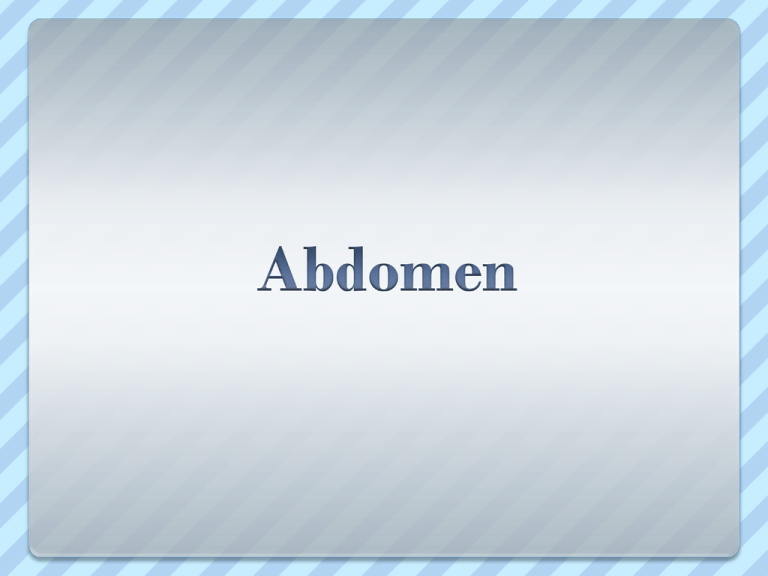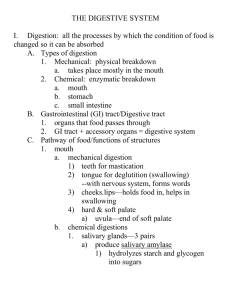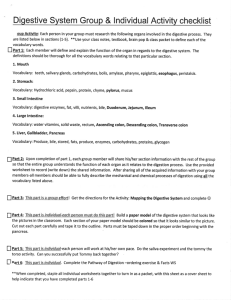Abdomen
advertisement

Abdomen Abdomen is the part of the trunk between the thorax and pelvis. It is covered by the musculoaponeurotic walls anterolaterally, the diaphragm superioly, and muscles of the pelvis inferiorly, which are suspended between and supported by the inferior thoracic skeleton, pelvic girdle and semirigid lumbar vertebrae posteriorly. Abdomial Regions Two vertical lines midclavicular lines Two horizontal lines subcostal plane and trans tubercular plane R. & L. Hypochondriac Epigastric R. & L. Lumbar Umbilical R. & L. Iliac Hypogastric or pubic Abdominal wall The wall consists of skin and subcutaneous tissue(superficial fascia) composed of fat,muscles and their aponeuroses and deep fascia, and parietal peritoneum Inferior to umblicus, the subcutaneous tissue has two layers Superficial fatty layer(camper fascia) Deep membranous layer(scarpa fascia) The membranous layer continues inferiorly to perineal region as superficial Muscles of the abdominal wall 3 flat muslces(external oblique,internal oblique and transverse abdominal) and 2 vertical muscles(rectus abdominus and pyramidalis) Esophagus Esophagus, a muscular tube is continuous with laryngopharynx. The pharyngoesophageal junction has the superior esophageal sphinchter, a constriction producted by the cricopharyngeal part of the inferior constrictor muscle, is the narrowest part of esophagus When the esophagus is empty it has a slit like lumen which expands when the food bolus descends. The cervical esophagus lies between trachea and cervical vertebral column. The esophagus remains posterior to the arch of aorta, left main bronchus and left atrium and then it passes through the esophageal hiatus in the diaphragm at the level of T10 vertebrae. thoracic esophagus The thoracic esophagus has 3 constrictions because of the compression of Cervical constriction: at the beginning of phryngo-esophageal junction Thoracic constriction: compound constriction caused by the compression of arch of aorta and left main bronchus Diaphragmatic constriction: when it passes thru the diaphragm Abdominal esophagus Abdominal esophagus after passing through the esophagus is only 1.25cm long and it ends in the cardiac orifice of the stomach. Gastro esophageal junction lies at the levl of t11 at the tip of xiphoid process. Immediately superior to this junction, the diaphragmatic musculature forms the physiologic eesophageal sphincter stomach The stomach is the expanded part of the alimentary tract between the esophagus and the small intestine. Its functions are 1. Acts as a reservoir of food 2. Enzymatic and mechanical digestion An empty stomach is only slightly larger than large intestine which it is capable of considerable expansion that it can hold 2-3 L of food. Stomach The stomach has 4 parts Cardia: the part sorrounding the cardiac orifice Fundus: the dilated superior part Body: the major part of stomach between the fundus and the pyloric antrum. Pyloric part: funnel shaped outflow region of stomach Small intestine Primary site for absorption of nutrients. Has 3 parts: 1. Duodenum 2. Jejunum 3. ileum Duodenum Shortest,widest and more fixed part of small intestine Bile and main pancreatic ducts enter through Hepatopancreatic ampulla Celiac trunk and superior mesentric artery supplies the blood. Jejunum and ileum together is 6-7 m long. Superior mesentric artery(direct branch of aorta) supplies the jejunum and ileum Large intestine Water is absorbed from indigestible residues of liquid chyme, converting it into feces. It consists of 1. Cecum 2. Appendix 3. Ascending colon 4. Transverse 5. Descending 6. Sigmoid 7. Rectum 8. Anal canal Cecum and appendix Cecum is blind intestinal pouch approximately 7.5cm in both length and breadth, located in the right lower quadrant. Appendix is a blind intestinal diverticulum containing masses of lymphoid tissue Appendix arises from the postero medial aspect of the ceum inferior to the ileocecal junction. The cecum is supplied by the ileocolic artery, the terminal branch of SMA. The appendicular artery, the branch of ileocolic artery supplies the appendix colon The ascending colon is narrower than cecum. Ileocolic and right colic arteries, the branches of SMA supplies the ascending colon. The transverse colon is 45 cm long and is most mobile part of large intestine, extending from right to left colic flexure Middle colic artery,branch of SMA supplies the transverse colon. Descending colon passes anterior to the lateral border of left kidney Sigmoid colon is characterized by the Sshaped loop of variable length The arterial supply is thru left colic and sigmoid arteries, branches of inferior mesentric artery. Rectum is the fixed terminal part of large intestine,has 3 sharp lateral flexures Superior,interme diate and inferior.





